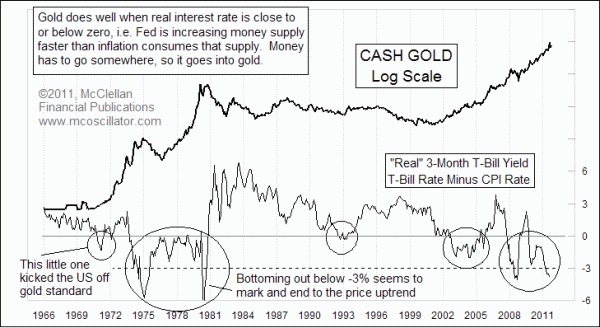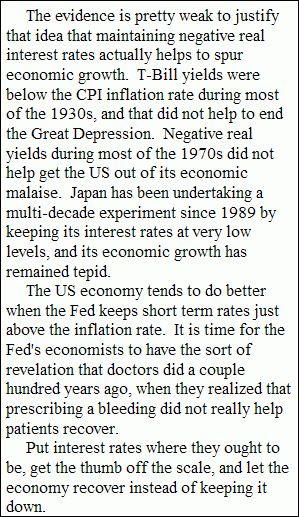Negative Real Yields, Too Much of a Good Thing

Free Chart In Focus email
Delivered to you every week
I hear more and more analysts talking about how negative real interest rates are a bullish factor for gold. That is a true statement, and it is something I addressed here back in January 2010. The circles in the chart highlight instances of negative real T-Bill yields, and they are generally associated with rising gold prices. I do get worried, though, when everybody starts to recognize a bullish factor for anything.
We are seeing negative real interest rates right now because of a conscious choice that the FOMC is making. Congress gave the Fed a dual mandate--maximum employment and stable prices. Since 2008, the Fed has been ignoring the mandate for stable prices in favor of keeping short term interest rates effectively at zero, in hopes that it will help to stimulate economic activity and therefore restore jobs growth.
Jobs have not yet come back as fast as everybody would like, but consumer prices have been rising. The CPI-U is up 3.9% from a year ago, and PPI is up 6.9%. Having higher inflation while interest rates remain low means that the negative real interest rate on T-Bills goes to an even more negative level. And while that is a bullish factor for gold prices, it may be too much of a good thing.
What I would like you to notice in this week's chart is that when the real yield gets down below -3%, that tends to mark a terminal point for an uptrend in gold prices. I don't mean exactly today or tomorrow, but in the really long term a condition like this tends to mark important tops for gold prices. The reason it works this way is that at some point this sort of condition gets so big that somebody decides to do something about it. 
Back in 1981, that somebody was Fed Chairman Paul Volcker, who finally took short term rates up above the inflation rate and thereby helped to snuff out the runaway inflation we were seeing back then. Those higher rates made it more expensive to speculate in gold, because investors would miss out on the chance to earn big yields by investing elsewhere. So money came back out of the gold market to chase those higher yields, and the price of gold fell.
In 2008, the real yield on T-Bills got down to -4.0%, as a reflection of the wealth destruction that was going on everywhere that year. Gold prices finally fell in sympathy because investors turned to their gold holdings as a "source of funds" to cover other losses.
Now we are once again seeing real yields well below that -3% threshold, and while it is still a bullish factor for gold prices, it also may be the sign that the good times for the gold bulls may be nearing an end. At some point, the FOMC is going to remember that it has a DUAL mandate, and that the stable prices part of that mandate has been ignored for too long.
Exceeding the -3% threshold does not mean that the Fed has to wake up and start doing its job right at this moment. It just says that they are increasingly likely to do so. Gold investors should take heed, and understand the negative implications (for gold prices) of the Fed actually deciding to do its job, whenever that might happen.
Exceeding the -3% threshold also does not specifically mean that the top is in for gold prices. When the top might come in is something that we address for subscribers of our twice monthly McClellan Market Report and our Daily Edition. Why not take a look?
Tom McClellan
Editor, The McClellan Market Report
Jan 08, 2010
The One Real Fundamental Factor Driving Gold Prices |
Dec 18, 2009
Drop in inflation should bring DROP in crime |
Feb 19, 2010
Real Yields and the Dollar |
Sep 09, 2011
Gold Price is a Measure of Dollar’s Debasement |